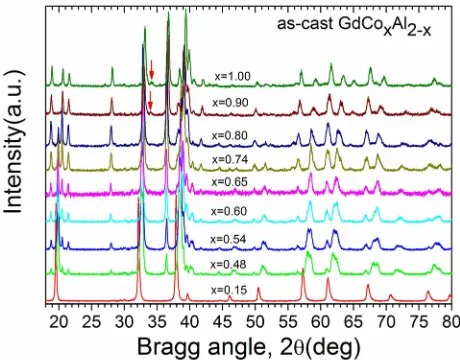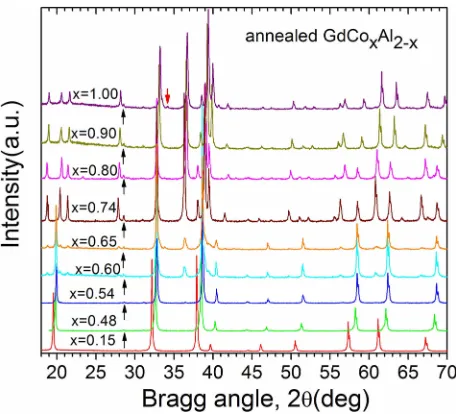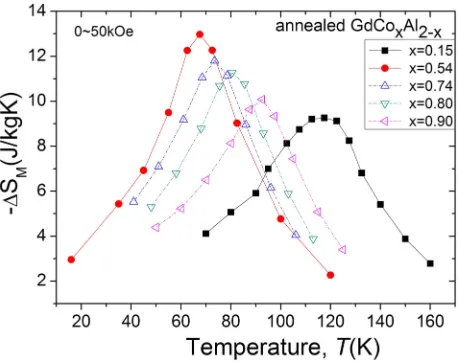Electrical and Computer Engineering Publications
Electrical and Computer Engineering
2014
Magnetocaloric effect in GdCoxAl2−x system for
(0.15 ≤ x ≤ 1) compositions
H. Fu
University of Electronic Science and Technology of China
M. Ravi Hadimani
Iowa State University, hadimani@iastate.edu
Z. Ma
University of Electronic Science and Technology of China
M. X. Wang
University of Electronic Science and Technology of China
B. H. Teng
University of Electronic Science and Technology of China
See next page for additional authors
Follow this and additional works at:
http://lib.dr.iastate.edu/ece_pubs
Part of the
Electromagnetics and Photonics Commons
The complete bibliographic information for this item can be found at
http://lib.dr.iastate.edu/
ece_pubs/22
. For information on how to cite this item, please visit
http://lib.dr.iastate.edu/
howtocite.html
.
Magnetocaloric effect in GdCoxAl2−x system for (0.15 ≤ x ≤ 1)
compositions
Abstract
Structure and magnetic properties of the GdAl2-GdCo2 system including magnetocaloric effecthave been investigated for various compositions. The as-cast GdCox Al 2-x alloys prepared by arc-melting crystallize in the dual-phase structure of cubic MgCu2-type and hexagonal MgZn2-type phases. All the as-cast dual-phase alloys exhibit only one magnetic phase transition near 77 K even though two ferrimagnetic phases coexist. The magnetic transition was broadened by the continuous transitions of the component phases, which resulted in enhancement of relative cooling power at the expense of the magnetic entropy changes.
Keywords
Ames Laboratory, Aluminum, Alloy phase transitions, Magnetic phase transitions, Crystal structure, Crystalline alloys
Disciplines
Electromagnetics and Photonics
Comments
The following article appeared inJournal of Applied Physics115 (2014): 17A914 and may be found at
http://dx.doi.org/10.1063/1.4863167.
Rights
Copyright 2014 American Institute of Physics. This article may be downloaded for personal use only. Any other use requires prior permission of the author and the American Institute of Physics.
Authors
H. Fu, M. Ravi Hadimani, Z. Ma, M. X. Wang, B. H. Teng, and David C. Jiles
Magnetocaloric effect in GdCoxAl2x system for (0.15x1) compositions
H. Fu, R. L. Hadimani, Z. Ma, M. X. Wang, B. H. Teng, and D. C. Jiles
Citation: Journal of Applied Physics 115, 17A914 (2014); doi: 10.1063/1.4863167
View online: http://dx.doi.org/10.1063/1.4863167
View Table of Contents: http://scitation.aip.org/content/aip/journal/jap/115/17?ver=pdfcov
Published by the AIP Publishing
Articles you may be interested in
Table-like magnetocaloric effect in the Gd-Co-Al alloys with multi-phase structure
Appl. Phys. Lett. 104, 072401 (2014); 10.1063/1.4865554
Giant magnetocaloric and magnetoresistance effects in ferrimagnetic Mn1.9Co0.1Sb alloy
Appl. Phys. Lett. 104, 022410 (2014); 10.1063/1.4862332
Low hysteresis and large room temperature magnetocaloric effect of Gd5Si2.05 x Ge1.95 x Ni2 x (2x = 0.08, 0.1) alloys
J. Appl. Phys. 113, 17A916 (2013); 10.1063/1.4795434
Structures and magnetocaloric effects of Gd65 x RE x Fe20Al15 (x=0–20; RE=Tb, Dy, Ho, and Er) ribbons
J. Appl. Phys. 109, 07A933 (2011); 10.1063/1.3561447
Magnetic phase transitions and magnetocaloric properties of (Gd12-xTbx)Co7 alloys
J. Appl. Phys. 109, 07A919 (2011); 10.1063/1.3551736
Magnetocaloric effect in GdCo
xAl
22xsystem for (0.15
£
x
£
1) compositions
H. Fu,1R. L. Hadimani,2,3,a)Z. Ma,1M. X. Wang,1B. H. Teng,1and D. C. Jiles2,3 1
School of Physical Electronics, University of Electronic Science and Technology of China, Chengdu 610054, People’s Republic of China
2
Department of Electrical and Computer Engineering, Iowa State University, Ames, Iowa 50011, USA 3
U.S. Department of Energy, Ames Laboratory, Ames, Iowa 50011, USA
(Presented 7 November 2013; received 23 September 2013; accepted 28 October 2013; published online 6 February 2014)
Structure and magnetic properties of the GdAl2-GdCo2 system including magnetocaloric effect have been investigated for various compositions. The as-cast GdCoxAl2-x alloys prepared by arc-melting crystallize in the dual-phase structure of cubic MgCu2-type and hexagonal MgZn2-type phases. All the as-cast dual-phase alloys exhibit only one magnetic phase transition near 77 K even though two ferrimagnetic phases coexist. The magnetic transition was broadened by the continuous transitions of the component phases, which resulted in enhancement of relative cooling power at the expense of the magnetic entropy changes.VC 2014 AIP Publishing LLC.
[http://dx.doi.org/10.1063/1.4863167]
I. INTRODUCTION
Laves phases, RCo2and RAl2(R¼rare earth), crystal-lize in the MgCu2-type cubic structure. These have been widely studied for magnetocaloric effect (MCE) due to the fact that both first-order and second-order MCE materials can be found in these alloy series.1–4 In the pseudobinary GdCo2-GdAl2 system, there are two cubic MgCu2-type terminal phases, GdCo2 and GdAl2 and one hexagonal MgZn2-type intermediate phase GdCo0.74Al1.26.5 All the three phases undergo second-order phase transitions. In our previous study,6we reported that GdCo0.65Al1.35alloy con-sisted of both cubic and hexagonal phases and their magnetic transitions were coupled at 70 K, which resulted in large magnetic entropy change and relative cooling power (RCP) of 11.0 J/kg K and 628 J/kg for 050 kOe field changes, respectively. In this paper, we have investigated the structure and MCE of the GdCo2-GdAl2 system for other composi-tions. We report the existence of coupling of two magnetic transitions in the dual-phase alloys for other compositions as well.
II. SAMPLE PREPARATION AND EXPERIMENTAL DETAILS
Gd, Co, and Al metals with purities of 99.2, 99.9, and 99.99 wt. %, respectively, were used to prepare pseudobinary GdCo2-GdAl2alloys. The alloy buttons of about 23 g each were re-melted four times in a Ti-gettered argon atmosphere in an arc furnace. Annealing was performed at 900C for 24 h in evacuated sealed quartz tubes. The crystal structures were examined by powder x-ray diffraction (XRD) using a Cu Ka radiation. The magnetic properties were measured
by using a superconducting quantum interference device (SQUID).
III. RESULTS AND DISCUSSIONS
[image:4.612.322.552.544.724.2]Fig. 1 shows the XRD patterns of the nonequilibrium as-cast GdCoxAl2x alloys prepared by arc-melting with x¼0.15, 0.48, 0.54, 0.60, 0.65, 0.74, 0.80, 0.90, and 1.00. It can be seen that when x¼0.15, the alloys adopt the cubic single phase structure; when 0.48x0.80, the alloys are double-phase structure with cubic and hexagonal phases; when x¼0.90 and 1.00, the alloys consist of hexagonal main phase and minor phase of Gd2Co2Al indicated by the down arrow. For the GdCo0.90Al1.10 and GdCoAl alloys, the ratio of Gd2Co2Al phase is about 2 wt. % and 4 wt. %, respectively. Fig. 2 shows the XRD patterns of annealed GdCoxAl2x alloys. It can be seen that when x0.54, the alloys adopt the cubic single phase structure; when 0.60x0.65, the alloys show the dual-phases of cubic and hexagonal phases; when 0.74x0.90, the alloys crys-tallize in the hexagonal single phase; when x¼1.00, the alloy of GdCoAl consists of main phase with MgZn2-type structure and minor phase of Gd2Co2Al, which can be
FIG. 1. XRD patterns of the as-cast GdCoxAl2x(0.15x1) alloys. a)Author to whom correspondence should be addressed. Electronic mail:
hadimani@iastate.edu.
0021-8979/2014/115(17)/17A914/3/$30.00 115, 17A914-1 VC2014 AIP Publishing LLC
detected by its strongest diffraction peak located at 2h¼34.5 indicated by the down arrow and its content is about 1 wt. %.
The temperature vs. magnetization with an applied field of 0.1 kOe for the as-cast dual-phase alloys are shown in Fig.3. The Curie temperatures (TCs) are listed in TableI.
Even though the alloys consist of two ferrimagnetic phases, a single magnetic transition has been observed. TCs of the
alloys with x¼0.48, 0.54, and 0.60 were determined to be 77 K. Near the transition temperatures, the magnetization decreases rapidly with the increasing temperature for the alloys with x¼0.48 and 0.54 compared with that of x¼0.60, 0.74, and 0.80 as shown in Fig.3. The rapid change in magnetization is similar to any typical ferromagnetic tran-sition in theirMvs.Tcurves. This is due to the fact thatTCs
of the cubic and hexagonal phases are so close that they appear to be coupled together. However, in Fig.3, careful observation reveals that transitional regions indicated by the circles are smoother when the temperatures are lower than theTCs. This suggests that the minor phase with hexagonal
structure plays a role in smoothing the magnetic phase transi-tion. Further increasing the Co content, the amount of
hexagonal phase increases and the slopes of the M vs. T
curve gradually reduce for the alloys with x¼0.60, 0.74, and 0.80. The reason for the reduction in the slope can be inter-preted as: when theTCof the hexagonal phase increases, the
difference between theTCs of the two phases becomes larger
and thus the magnetic transitions are broadened to a wider temperature range.
M vs. T at an applied magnetic field of 0.1 kOe for the annealed single-phase alloys is shown in Fig. 4. The Curie temperaturesTCs are listed in TableI. All the alloys exhibit
one abrupt phase transition near their TC’s except for the
x¼0.15 alloy. It seems that the annealed GdCo0.15Al1.85 alloy has two magnetic phase transitions near its TC, which suggests that the alloy may have extra minor phase, which cannot be detected within the XRD resolution. For the alloys with cubic phase, the TCs decrease with the increasing Co
content. The magnetic moments of the heavy rare earth ele-ments in these alloys are always antiparallel to those of the transition metals. So, the decrease ofTCscan be attributed to
the presence of negative Gd-Co interactions. In contrast, for alloys with the hexagonal phase, the TCs increase with the
[image:5.612.60.288.61.268.2]increasing Co content, which can be understood by the
[image:5.612.328.546.61.227.2]FIG. 2. XRD patterns of the annealed GdCoxAl2x(0.15x1) alloys.
FIG. 3. M vs. T of the as-cast GdCoxAl2xwith dual-phase structure at an applied field of 0.1 kOe.
TABLE I. Curie temperature (TC), maxima of magnetic entropy changes (DSMmax), and the RCP of the annealed and as-cast GdCoxAl2x (0.15x1) alloys.
Annealed As-cast Alloys TC (K) DSMmax (J/kg K) RCP (102J/kg)
TC (K)
DSMmax (J/kg K)
RCP (102J/kg)
GdCo0.15Al1.85 119 9.2 6.3 … … …
GdCo0.48Al1.52 74 … … 77 … …
GdCo0.54Al1.46 68 12.9 6.5 77 12.1 6.9
GdCo0.60Al1.40 … … … 77 11.4 6.7
GdCo0.65Al1.35 … … … 70 11.0 6.4
GdCo0.74Al1.26 72 11.8 6.4 76 … … GdCo0.80Al1.20 80 11.3 6.0 77 10.1 6.2
GdCo0.90Al1.10 92 10.1 5.7 … … … FIG. 4. M vs. T of the annealed GdCoxAl2xwith single phase at an applied field of 0.1 kOe.
17A914-2 Fuet al. J. Appl. Phys.115, 17A914 (2014)
[image:5.612.323.551.557.740.2] [image:5.612.51.296.620.765.2]contribution of the stronger Co-Co interactions. For the hex-agonal phase, the lowest TC of 72K is obtained in the
GdCo0.74Al1.26 alloy. Therefore, the TCs of the cubic and
hexagonal phases are very close to each other near 70 K at their maximum solid solubility of Co and Al.
The temperature dependences of magnetic entropy changes for three typical as-cast dual-phase alloys and five annealed alloys are shown in Figs. 5 and 6, respectively. They are calculated using the Maxwell relation using the magnetization isotherms, which are not shown for concise-ness. The maxima of magnetic entropy changes (DSMmax)
forDH¼50 kOe as well as RCP values,7which is defined as the product ofDSMmaxand the full width at half maximum
(dFWHM) in the curves of magnetic entropy change vs.
tem-perature, are listed in TableI. For the annealed alloys, it can be seen that DSMmaxs increased andTCdecreased for both
the cubic and hexagonal phases, which is due to the contribu-tion of the decreasing heat capacity with decreasing ordering temperature.7The RCPs vary in a way similar toDSMmaxs.
In addition, DSMmax of the cubic phase, 12.7 J/kg K, is
larger than that of the hexagonal phase, 11.8 J/kg K (see TableI). Like the annealed alloys,DSMmaxand RCP of the
as-cast alloys decrease with the increased ordering tempera-ture, TC. Compared with the annealed alloys, the as-cast alloys with same composition have lower DSMmaxs but
higher RCP. In other words, the dual-phase structure favors the enhancement of RCP at the expense of DSMmax. For
example, the DSMmax of the as-cast GdCo0.54Al1.46 alloy, 12.1 J/kg K, is 6% lower than that of the annealed alloy, 12.9 J/kg K; however, its RCP is 6% higher.
IV. CONCLUSION
The structure and MCE of the GdCoxAl2x (0.15x1) alloys have been investigated in this work. In the non-equilibrium state, the alloys with 0.48x0.80 crystallize in a dual-phase structure including cubic and hex-agonal phases. All the as-cast dual-phase alloys exhibit one magnetic transition near 77 K and the magnetic transitions are broadened by the continuous transitions of the compo-nent phases, which result in the enhancement of RCP. In the equilibrium state, for the cubic phase, the TCs decrease but
DSMmax’s increase with the increasing Co. However, for
the hexagonal phase, the TCs increase but DSMmax’s
decrease with the increased Co.
ACKNOWLEDGMENTS
This work was supported by the National Natural Science Foundation of China (No. 51271049) and the Fundamental Research Funds for the Central Universities (No. ZYGX2010J050).
1
N. K. Singh, K. G. Suresh, A. K. Nigam, S. K. Malik, A. A. Coelho, and S. Gama,J. Magn. Magn. Mater.317, 68 (2007).
2K. A. Gschneidner Jr., V. K. Pecharsky, and A. O. Tsoko,Rep. Progress
Phys.68, 1479 (2005). 3
M. Khan, K. A. Gschneidner, Jr., and V. K. Pecharsky,J. Appl. Phys.110, 103912 (2011).
4R. L. Hadimani, Y. Melikhov, J. E. Snyder, and D. C. Jiles,J. Appl. Phys.
103, 033906 (2008). 5
H. Oesterreicher and W. E. Wallace,J. Less-Common Met.13, 91 (1967). 6
H. Fu, Q. Zheng, and M. X. Wang,Appl. Phys. Lett.99, 162504 (2011). 7K. A. Gschneidner and V. K. Pecharsky,Annu. Rev. Mater. Sci.30, 387
[image:6.612.60.291.62.240.2](2000). FIG. 5.DSMVs. T of the as-cast GdCoxAl2xwith dual-phase structure in
the field from 0 to 50 kOe.
FIG. 6.DSMVs. T of the annealed GdCoxAl2xalloys in the field from 0 to 50 kOe.
[image:6.612.60.289.292.473.2]

